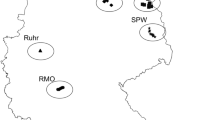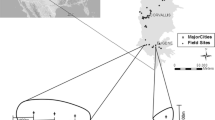Abstract
Because organisms respond to the environment at different scales, it is important to develop ways of determining the appropriate scales for a specific ecological process and organism. We consider whether the relative importance of different scales is associated with organism mobility, and whether this relationship is independent of landscape characteristics. We observed abundances of particular species for vascular plants, ground-dwelling beetles and breeding birds along eight 2-km transects of 40 sampling stations each, distributed over four sites along the regional gradient from shortgrass steppe in central Colorado to tallgrass prairie in central Kansas. For each transect and taxonomic group, the relative importance of factors measured at the trap scale (1 m; soil texture and hardness, vegetation height, bare ground), at the local scale (10 m; density of shrubs and cacti) and at the landscape scale (30 m; Landsat 7 TM spectral bands, slope and elevation) was assessed using hierarchical canonical variance partitioning with forward selection of explanatory variables. Plant, beetle and bird community composition was explained by environmental factors measured at all three scales. Factor influence was more consistent between transects and between plants and beetles for the more homogeneous landscapes of the shortgrass steppe than for the more heterogeneous landscapes of the tallgrass prairie. We conclude that, independent of the mobility of a taxonomic group, factors at several scales are important in explaining community composition. The importance of different scales shifts along a regional gradient, and the variability between sites is high even for nearby sites.
Similar content being viewed by others
References
J.F. Addicott J.M. Aho M.F. Antolin D.K. Padilla J.S. Richardson D.A. Soluk (1987) ArticleTitleEcological neighborhoods – scaling environmental patterns Oikos 49 340–346
T.F.H. Allen T.B. Starr (1982) Hierarchy: Perspectives for Ecological Complexity University of Chicago Press ChicagoIllinois, USA
D. Borcard P. Legendre P. Drapeau (1992) ArticleTitlePartialling out the spatial component of ecological variation Ecology 73 1045–1055
J.H. Brown (1984) ArticleTitleOn the relationship between abundance and distribution of species Am. Nat. 124 255–279 Occurrence Handle10.1086/284267
J.H. Brown M.V. Lomolino (1998) Biogeography Sinauer SunderlandMassachusetts, USA
S.T. Buckland D.R. Anderson K.P. Burnham J.L. Laake (1993) Distance Sampling: Estimating Abundance of Biological Populations, 1st edn Chapman & Hall New York, USA
G. Cottam J.T. Curtis (1956) ArticleTitleThe use of distance measures in phytological sampling Ecology 37 451–460
S.A. Cushman K. McGarigal (2002) ArticleTitleHierarchical, multi-scale decomposition of species–environment relationships Landscape Ecol. 17 637–646 Occurrence Handle10.1023/A:1021571603605
M.B. Dodd W.K. Lauenroth I.C. Burke P.L. Chapman (2002) ArticleTitleAssociations between vegetation patterns and soil texture in the shortgrass steppe Plant Ecol. 158 127–137 Occurrence Handle10.1023/A:1015525303754
M. Dufrene P. Legendre (1997) ArticleTitleSpecies assemblages and indicator species: the need for a flexible asymmetrical approach Ecol. Monogr. 67 345–366
ESRI 2002. ArcGIS version 7.1. ESRI, Redlands, CaliforniaUSA.
A.J. Hansen D.L. Urban (1992) ArticleTitleAvian response to landscape pattern – the role of species life histories Landscape Ecol. 7 163–180 Occurrence Handle10.1007/BF00133308
T.B. Kinraide (1984) ArticleTitleThe influence of soil texture on the vegetation of a grazedshort-grass prairie in Colorado Southwest. Nat. 29 277–287
M. Koivula D.J. Kotze L. Hiisivuori H. Rita (2003) ArticleTitlePitfall trap efficiency: do trap sizecollecting fluid and vegetation structure matter? Entomol. Fennica 14 1–14
K.I. Larsen T.T. Work F.F. Purrington (2003) ArticleTitleHabitat use patterns by ground beetles (Coleoptera: Carabidae) of northeastern Iowa Pedobiologia 47 288–299 Occurrence Handle10.1078/0031-4056-00192
P. Legendre L. Legendre (1998) Numerical Ecology EditionNumber2 Elsevier AmsterdamThe Netherlands
R.L. McCulley I.C. Burke (2004) ArticleTitleMicrobial community composition across the Great Plains: landscape versus regional variability Soil Sci. Soc. Am. J. 68 106–115
B. McCune (1997) ArticleTitleInfluence of noisy environmental data on canonical correspondence analysis Ecology 78 2617–2623
N.E. McIntyre (1997) ArticleTitleScale-dependent habitat selection by the darkling beetle Eleodes hispilabris (Coleoptera: Tenebrionidae) Am. Midl. Nat. 138 230–235
Nature Conservancy, T. 2001. Conservation by Design. The Nature Conservancy, Arlington, VirginiaUSA.
J.L. Ohmann T.A. Spies (1998) ArticleTitleRegional gradient analysis and spatial pattern of woody plant communities of Oregon forests Ecol. Monogr. 68 151–182
M.W. Palmer (1993) ArticleTitlePutting things in even better order – the advantages of canonical correspondence-analysis Ecology 74 2215–2230
R. Panzer M.W. Schwartz (1998) ArticleTitleEffectiveness of a vegetation-based approach to insect conservation Conserv. Biol. 12 693–702 Occurrence Handle10.1046/j.1523-1739.1998.97051.x
R.E. Ricklefs (1987) ArticleTitleCommunity diversity – relative roles of local and regional processes Science 235 167–171
J.J. Rykken D.E. Capen S.P. Mahabir (1997) ArticleTitleGround beetles as indicators of land type diversity in the Green Mountains of Vermont Conserv. Biol. 11 522–530 Occurrence Handle10.1046/j.1523-1739.1997.95336.x
D.C. Schneider (1994) Quantitative Ecology: Spatial and Temporal Scaling Academic Press San DiegoCaliforniaUSA
P. Stapp (1997) ArticleTitleMicrohabitat use and community structure of darkling beetles (Coleoptera:Tenebrionidae) in shortgrass prairie: effects of season, shrub cover and soil type Am. Midl. Nat. 137 298–311
T.J. Stohlgren M.B. Falkner L.D. Schell (1995) ArticleTitleA modified-Whittaker nested vegetation sampling method Vegetatio 117 113–121 Occurrence Handle10.1007/BF00045503
C.J.F. Terbraak (1986) ArticleTitleCanonical correspondence-analysis – a new eigenvector technique for multivariate direct gradient analysis Ecology 67 1167–1179
U.S. Fish & Wildlife ServiceT. 1999. Conserving the Nature of America. Department of the InteriorWashington D.C., USA.
USGS 1998. US Geological Survey DEM 7.5 Quadrangle. US Geological Survey, Reston, VAUSA.
R.D. Weeks N.E. McIntyre (1997) ArticleTitleA comparison of live versus kill pitfall trapping techniques using various killing agents Entomol. Exp. Appl. 82 267–273 Occurrence Handle10.1046/j.1570-7458.1997.00140.x
R.H. Whittaker (1975) Communities and Ecosystems EditionNumber2 Macmillan New York, USA
J.A. Wiens (1989) ArticleTitleSpatial scaling in ecology Funct. Ecol. 3 385–397
Author information
Authors and Affiliations
Corresponding author
Rights and permissions
About this article
Cite this article
Bossenbroek, J.M., Wagner, H.H. & Wiens, J.A. Taxon-dependent Scaling: Beetles, Birds, and Vegetation at Four North American Grassland Sites. Landscape Ecol 20, 675–688 (2005). https://doi.org/10.1007/s10980-004-5651-4
Received:
Accepted:
Issue Date:
DOI: https://doi.org/10.1007/s10980-004-5651-4




